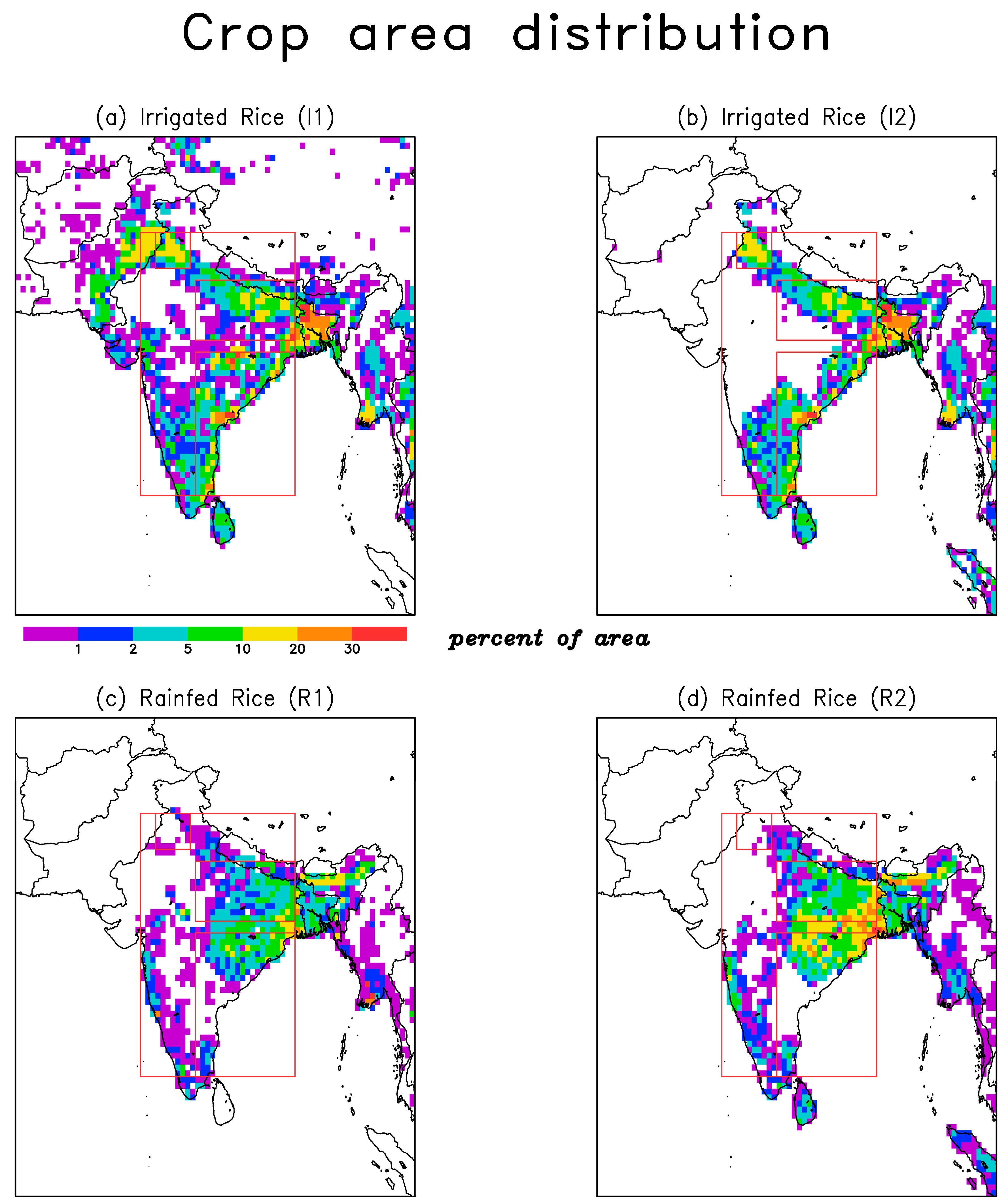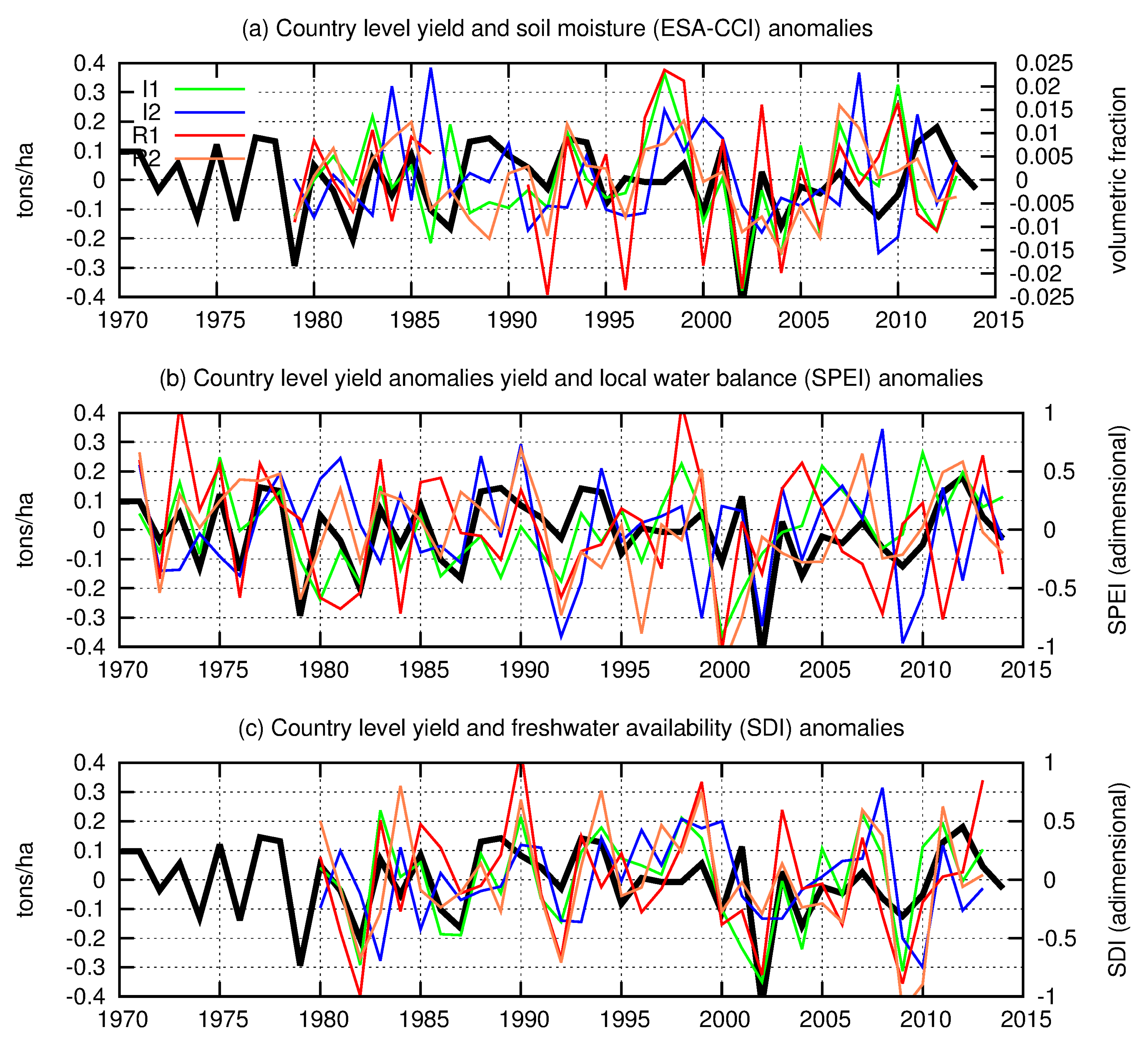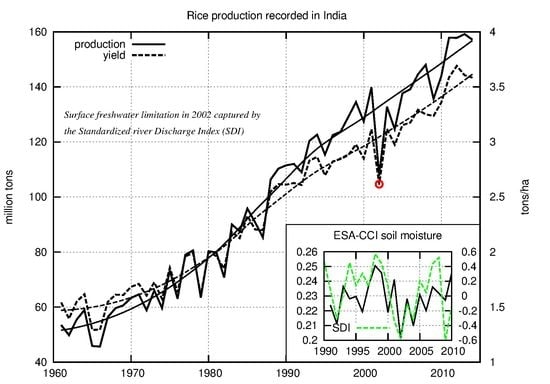Surface Freshwater Limitation Explains Worst Rice Production Anomaly in India in 2002
Abstract
:1. Introduction
- the ESA-CCI soil moisture index [22], computed on remotely sensed measurements of near surface soil moisture (i.e., the few top centimeters), here considered as the observational reference;
- the standardized precipitation evapotranspiration index (SPEI [21]), as a proxy for the soil moisture anomalies given by the local soil water balance (i.e., precipitation minus evapotranspiration);
- the standardized river discharge index (SDI, this study), as a proxy for the anomalies of water available for irrigation and paddy field flooding, here assumed to be related to the river discharge originated by the upstream runoff.
2. Materials and Methods
2.1. Rice Cropping Pattern in India
2.2. Agricultural Data
2.3. Soil Moisture Observations
2.4. Local Soil Moisture Proxy
2.5. Non-Local Freshwater Availability
2.6. Computation of Annual Time-Series at Country Level
- all gridded datasets are interpolated onto a 0.5° × 0.5°common grid;
- the indexes are computed over period when the crop is more sensitive to climate anomalies independently for each cropping cycle (i.e., three months from harvesting as given by the MIRCA2000 dataset, see Section 2.1, Figure S1);
- when different cropping cycles are present in the same grid, weighted averages are computed using the relative contribution to the total harvested area as given by the MIRCA2000 dataset (Figure 2);
- aggregations at the national (and regional) level are computed by using again the MIRCA2000 harvested area as weighting factor;
- LOESS detrending is performed to compare the indexes with the yield anomaly time-series from FAOSTAT.
3. Results
3.1. National Level Analysis
3.2. Regional Level Analysis
4. Discussion
5. Conclusions
Supplementary Materials
Author Contributions
Conflicts of Interest
References
- Gumma, M.K.; Thenkabail, P.S.; Teluguntla, P.; Rao, M.N.; Mohammed, I.A.; Whitbread, A.M. Mapping rice-fallow cropland areas for short-season grain legumes intensification in south asia using modis 250 m time-series data. International. J. Dig. Earth 2016, 9, 981–1003. [Google Scholar] [CrossRef] [Green Version]
- Gumma, M.K.; Nelson, A.; Thenkabail, P.S.; Singh, A.N. Mapping rice areas of south asia using modis multitemporal data. J. Appl. Remote Sens. 2011, 5, 053547. [Google Scholar] [CrossRef]
- Palazzi, E.; von Hardenberg, J.; Provenzale, A. Precipitation in the Hindu-Kush Karakoram Himalaya: Observations and future scenarios. J. Geophys. Res. 2013, 118, 85–100. [Google Scholar] [CrossRef]
- Portmann, F.T.; Siebert, S.; Döll, P. MIRCA2000—Global monthly irrigated and rainfed crop areas around the year 2000: A new high-resolution data set for agricultural and hydrological modeling. Glob. Biogeochem. Cycles 2010, 24, GB1011. [Google Scholar] [CrossRef]
- Pekel, J.-F.; Cottam, A.; Gorelick, N.; Belward, A.S. High-resolution mapping of global surface water and its long-term changes. Nature 2016, 540, 418–422. [Google Scholar] [CrossRef] [PubMed]
- JRC Global Surface Waters Explorer. Available online: https://global-surface-water.appspot.com/ (accessed on 22 September 2017).
- Biggs, T.W.; Scott, C.A.; Gaur, A.; Venot, J.-P.; Chase, T.; Lee, E. Impacts of irrigation and anthropogenic aerosols on the water balance, heat fluxes, and surface temperature in a river basin. Water Resour. Res. 2008, 44, W12415. [Google Scholar] [CrossRef]
- De Vrese, P.; Hagemann, S.; Claussen, M. Asian irrigation, African rain: Remote impacts of irrigation. Geophys. Res. Lett. 2016, 43, 3737–3745. [Google Scholar] [CrossRef]
- Directorate of Rice Development of the Indian Agricultural Ministry. Available online: http://drdpat.bih.nic.in/Downloads/Handbook-of-Statistics-2007.pdf (accessed on 19 October 2017).
- India Meteorological Department, Ministry of Earth Science. Available online: http://www.imd.gov.in/pages/monsoon_main.php (accessed on 5 November 2017).
- World Bank. Available online: https://data.worldbank.org/ (accessed on 10 October 2017).
- FAO; IFAD; WFP. The State of Food Insecurity in the World 2015. Meeting the 2015 International Hunger Targets: Taking Stock of Uneven Progress; FAO: Rome, Italy, 2015; Available online: http://www.fao.org/3/a-i4646e.pdf (accessed on 3 November 2017).
- Hallegatte, S.; Bangalore, M.; Bonzanigo, L.; Fay, M.; Kane, T.; Narloch, U.; Rozenberg, J.; Treguer, D.; Vogt-Schilb, A. Shock Waves: Managing the Impacts of Climate Change on Poverty. Climate Change and Development; World Bank: Washington, DC, USA, 2016; Available online: https://openknowledge.worldbank.org/handle/10986/22787 (accessed on 3 November 2017).
- Kumar, K.K.; Rajagopalan, B.; Hoerling, M.; Bates, G.; Cane, M. Unraveling the Mystery of Indian Monsoon Failure during El Niño. Science 2006, 314, 115–119. [Google Scholar] [CrossRef] [PubMed]
- Mujumdar, M.; Kumar, V.; Krishnan, R. The Indian summer monsoon drought of 2002 and its linkage with tropical convective activity over northwest Pacific. Clim. Dyn. 2007, 28, 743. [Google Scholar] [CrossRef]
- Ménégoz, M.; Gallée, H.; Jacobi, H.W. Precipitation and snow cover in the Himalaya: From reanalysis to regional climate simulations. Hydrol. Earth Syst. Sci. 2013, 17, 3921–3936. [Google Scholar] [CrossRef] [Green Version]
- Gaur, A.; Biggs, T.W.; Gumma, M.K.; Parthasaradhi, G.R.; Turral, H. Water scarcity effects on equitable water distribution and land use in major irrigation project—A case study in India. J. Irrig. Drain. Eng. 2008, 134, 26–35. [Google Scholar] [CrossRef]
- Biggs, T.W.; Gangadhara Rao, P.; Bharati, L. Mapping agricultural responses to water supply shocks in large irrigation systems, southern India. Agric. Water Manag. 2010, 97, 924–932. [Google Scholar] [CrossRef]
- Gumma, M.K.; Mohanty, S.; Nelson, A.; Arnel, R.; Mohammed, I.A.; Das, S.R. Remote sensing based change analysis of rice environments in Odisha, India. J. Environ Manag. 2015, 148, 31–41. [Google Scholar] [CrossRef] [PubMed]
- Zampieri, M.; Ceglar, A.; Dentener, F.; Toreti, A. Wheat yield loss attributable to heat waves, drought and water excess on the global, national and subnational scales. Environ. Res. Lett. 2017, 12, 064008. [Google Scholar] [CrossRef]
- Vicente-Serrano, S.M.; Gouveia, C.; Camarero, J.J.; Beguería, S.; Trigo, R.; López-Moreno, J.I.; Azorín-Molina, C.; Pasho, E.; Lorenzo-Lacruz, J.; Revuelto, J.; et al. Response of vegetation to drought time-scales across global land biomes. PNAS 2013, 110, 52–57. [Google Scholar] [CrossRef] [PubMed] [Green Version]
- Dorigo, W.A.; Wagner, W.; Albergel, C.; Albrecht, F.; Balsamo, G.; Brocca, L.; Chung, D.; Ertl, M.; Forkel, M.; Gruber, A.; et al. ESA CCI Soil Moisture for improved Earth system understanding: State-of-the art and future directions. Remote Sens. Environ. 2017. [Google Scholar] [CrossRef]
- FAOSTAT. Available online: www.fao.org/faostat/ (accessed on 15 July 2017).
- Cleveland, W.S.; Devlin, S.J. Locally Weighted Regression: An Approach to Regression Analysis by Local Fitting. J. Am. Stat. Assoc. 1988, 83, 596–610. [Google Scholar] [CrossRef]
- Kumar, S.V.; Peters-Lidard, C.D.; Santanello, J.A.; Reichle, R.H.; Draper, C.S.; Koster, R.D.; Nearing, G.; Jasinski, M.F. Evaluating the utility of satellite soil moisture retrievals over irrigated areas and the ability of land data assimilation methods to correct for unmodeled processes. Hydrol. Earth Syst. Sci. 2015, 9, 4463–4478. [Google Scholar] [CrossRef]
- Heinhuber, V.; Tulbure, M.G.; Broich, M. Modeling multidecadal surface water inundation dynamics and key drivers on large river basin scale using multiple time series of Earth-observation and river flow data. Water Resour. Res. 2017, 53, 1251–1269. [Google Scholar] [CrossRef]
- Teluguntla, P.; Ryu, D.; George, B.; Walker, J.P.; Malano, H.M. Mapping flooded rice paddies using time series of MODIS imagery in the Krishna River Basin, India. Remote Sens. 2015, 7, 8858–8882. [Google Scholar] [CrossRef]
- Dorigo, W.A.; Scipal, K.; Parinussa, R.M.; Liu, Y.Y.; Wagner, W.; de Jeu, R.A.M.; Naeimi, V. Error characterisation of global active and passive microwave soil moisture data sets. Hydrol. Earth Syst. Sci. 2010, 14, 2605–2616. [Google Scholar] [CrossRef] [Green Version]
- Meng, X.; Li, R.; Luan, L.; Lyu, S.; Zhang, T.; Ao, Y.; Han, B.; Zhao, L.; Ma, Y. Detecting hydrological consistency between soil moisture and precipitation and changes of soil moisture in summer over the Tibetan Plateau. Clim. Dyn. 2017. [Google Scholar] [CrossRef]
- Chakravorty, A.; Chahar, B.R.; Sharma, P.P.; Chanya, C.T. A regional scale performance evaluation of SMOS and ESA-CCI soil moisture products over India with simulated soil moisture from MERRA-Land. Remote Sens. Environ. 2017, 186, 524–527. [Google Scholar] [CrossRef]
- Sathyanadh, A.; Karipot, A.; Ranalkar, M.; Prabhakaran, T. Evaluation of soil moisture data products over Indian region and analysis of spatio-temporal characteristics with respect to monsoon rainfall. J. Hydrol. 2017, 542, 47–62. [Google Scholar] [CrossRef]
- Shrivastava, S.; Kar, S.C.; Sharma, A.R. Soil moisture variations in remotely sensed and reanalysis datasets during weak monsoon conditions over central India and central Myanmar. Theor. Appl. Climatol. 2016, 129, 305–320. [Google Scholar] [CrossRef]
- Cammalleri, C.V.; Vogt, J.; Bisselink, B.; de Roo, A. Comparing soil moisture anomalies from multiple independent sources over different regions across the globe. Hydrol. Earth Syst. Sci. Discuss. 2017. [Google Scholar] [CrossRef]
- Padhee, S.K.; Nikam, B.R.; Dutta, S.; Aggarwal, S.P. Using satellite-based soil moisture to detect and monitor spatiotemporal traces of agricultural drought over Bundelkhand region of India. GIScience Remote Sens. 2017, 54, 144–166. [Google Scholar] [CrossRef]
- Nath, R.; Nath, D.; Li, Q.; Chen, W.; Cui, X. Impact of drought on agriculture in the Indo-Gangetic Plain, India. Adv. Atmos. Sci. 2017, 34, 335–346. [Google Scholar] [CrossRef]
- Alfieri, L.; Burek, P.; Dutra, E.; Krzeminski, B.; Muraro, D.; Thielen, J.; Pappenberger, F. GloFAS—Global ensemble streamflow forecasting and flood early warning. Hydrol. Earth Syst. Sci. 2013, 17, 1161–1175. [Google Scholar] [CrossRef] [Green Version]
- Kauffeldt, A.; Wetterhall, F.; Pappenberger, F.; Salamon, P.; Thielen, J. Technical review of large-scale hydrological models for implementation in operational flood forecasting schemes on continental level. Environ. Model. Softw. 2015, 75, 68–76. [Google Scholar] [CrossRef]
- Balsamo, G.; Beljaars, A.; Scipal, K.; Viterbo, P.; van den Hurk, B.; Hirschi, M.; Betts, A.K. A Revised Hydrology for the ECMWF Model: Verification from Field Site to Terrestrial Water Storage and Impact in the Integrated Forecast System. J. Hydrometeorol. 2009, 10, 623–643. [Google Scholar] [CrossRef]
- Feyen, L.; Vrugt, J.A.; Nuall’ain, B.A.; van der Knijff, J.; De Roo, A. Parameter optimisation and uncertainty assessment for large-scale streamflow simulation with the LISFLOOD model. J. Hydrol. 2007, 332, 276–289. [Google Scholar] [CrossRef]
- Dee, D.P.; Uppala, S.M.; Simmons, A.J.; Berrisford, P.; Poli, P.; Kobayashi, S.; Andrae, U.; Balmaseda, M.A.; Balsamo, G.; Bauer, P.; et al. The ERA-Interim reanalysis: Configuration and performance of the data assimilation system. Q. J. R. Meteorol. Soc. 2011, 137, 553–597. [Google Scholar] [CrossRef]
- Zampieri, M.; Serpetzoglou, E.; Nikolopoulos, E.I.; Anagnostou, E.N.; Papadopoulos, A. Improving the Representation of River-Groundwater Interactions in Land Surface Modeling at the Regional Scale: Observational Evidence and Parameterization Applied in the Community Land Model. J. Hydrol. 2012, 420–421, 89–95. [Google Scholar] [CrossRef]
- Wu, D.; Anagnostou, E.N.; Wang, G.; Moges, S.; Zampieri, M. Improving the Surface-Ground Water Interactions in the Community Land Model: Case Study in the Blue Nile Basin. Water Resour. Res. 2014, 50, 8015–8033. [Google Scholar] [CrossRef]
- Elliott, J.; Deryng, D.; Müller, C.; Frieler, K.; Konzmann, M.; Gerten, D.; Glotter, M.; Flörke, M.; Wada, Y.; Best, N.; et al. Constraints and potentials of future irrigation water availability on agricultural production under climate change. Proc. Natl. Acad. Sci. USA 2014, 111, 3239–3244. [Google Scholar] [CrossRef] [PubMed] [Green Version]
- Schewe, J.; Levermann, A. A statistically predictive model for future monsoon failure in India. Environ. Res. Lett. 2012, 7, 044023. [Google Scholar] [CrossRef]
- Wada, Y.; Bierkens, M.F.P.; de Roo, A.; Dirmeyer, P.A.; Famiglietti, J.S.; Hanasaki, N.; Konar, M.; Liu, J.; Müller Schmied, H.; Oki, T.; et al. Human–water interface in hydrological modelling: Current status and future directions. Hydrol. Earth Syst. Sci. 2017, 21, 4169–4193. [Google Scholar] [CrossRef]
- Azad, S.; Rajeevan, M. Possible shift in the ENSO-Indian monsoon rainfall relationship under future global warming. Sci. Rep. 2016, 6, 20145. [Google Scholar] [CrossRef] [PubMed]
- Organisation for Economic Co-Operation and Development (OECD). Water Risk Hotspots for Agriculture; OECD Publishing: Paris, France, 2017. [Google Scholar] [CrossRef]
- Shukla, S.; Wood, A.W. Use of a standardized runoff index for characterizing hydrologic drought. Geophys. Res. Lett. 2008, 35. [Google Scholar] [CrossRef]
- Rodell, M.; Velicogna, I.; Famiglietti, J.S. Satellite-based estimates of groundwater depletion in India. Nature 2009, 460, 999–1002. [Google Scholar] [CrossRef] [PubMed]
- Tiwari, V.M.; Wahr, J.; Swenson, S.C. Dwindling groundwater resources in northern India, from satellite gravity observations. Geophys. Res. Lett. 2009, 36, L18401. [Google Scholar] [CrossRef]
- Gumma, M.K.; Kajisa, K.; Mohammed, I.A.; Whitbread, A.M.; Nelson, A.; Rala, A.; Palanisami, K. Temporal change in land use by irrigation source in tamil nadu and management implications. Environ. Monit. Assess. 2015, 187, 1–17. [Google Scholar] [CrossRef] [PubMed]
- Garg, K.K.; Karlberg, L.; Barron, J.; Wani, S.P.; Rockstrom, J. Assessing impact of agricultural water interventions at the Kothapally watershed, Southern India. Hydrol. Process. 2012, 26, 387–404. [Google Scholar] [CrossRef] [Green Version]
- Venot, J.P.; Sharma, B.R.; Rao, K.V.G.K. Krishna basin development: Interventions to limit downstream environmental degradation. J. Environ. Dev. 2008, 17, 269–291. [Google Scholar] [CrossRef]
- Gumma, M.K.; Thenkabail, P.S.; Muralikrishna, I.V.; Velpuri, M.N.; Gangadhararao, P.T.; Dheeravath, V.; Biradar, C.M.; Nalan, S.A.; Gaur, A. Changes in agricultural cropland areas between a water-surplus year and a water-deficit year impacting food security, determined using MODIS 250 m time-series data and spectral matching techniques, in the Krishna River basin (India). Int. J. Remote Sens. 2011, 32, 3495–3520. [Google Scholar] [CrossRef]
- Venot, J.P.; Reddy, V.R.; Umapathy, D. Coping with drought in irrigated South India: Farmers’ adjustments in Nagarjuna Sagar. Agric. Water Manag. 2010, 97, 1434–1442. [Google Scholar] [CrossRef]










| Correlations | I1 | I2 | R1 | R2 |
|---|---|---|---|---|
| ESA-CCI—SPEI | 0.45 * | 0.46 * | 0.47 * | 0.37 |
| ESA-CCI—SDI | 0.53 * | 0.65 * | 0.60 * | 0.50 * |
| SPEI—SDI | 0.51 * | 0.55 * | 0.56 * | 0.38 |
| Correlations | All India | Punjab-Haryana | Ganges Basin | West Coast |
|---|---|---|---|---|
| ESA-CCI—SPEI | 0.44 | 0.19 | −0.22 | 0.66 ** |
| ESA-CCI—SDI | 0.80 * | 0.73 * | 0.62 * | 0.80 * |
| SPEI—SDI | 0.15 | −0.003 | −0.41 | 0.37 |
© 2018 by the authors. Licensee MDPI, Basel, Switzerland. This article is an open access article distributed under the terms and conditions of the Creative Commons Attribution (CC BY) license (http://creativecommons.org/licenses/by/4.0/).
Share and Cite
Zampieri, M.; Carmona Garcia, G.; Dentener, F.; Gumma, M.K.; Salamon, P.; Seguini, L.; Toreti, A. Surface Freshwater Limitation Explains Worst Rice Production Anomaly in India in 2002. Remote Sens. 2018, 10, 244. https://doi.org/10.3390/rs10020244
Zampieri M, Carmona Garcia G, Dentener F, Gumma MK, Salamon P, Seguini L, Toreti A. Surface Freshwater Limitation Explains Worst Rice Production Anomaly in India in 2002. Remote Sensing. 2018; 10(2):244. https://doi.org/10.3390/rs10020244
Chicago/Turabian StyleZampieri, Matteo, Gema Carmona Garcia, Frank Dentener, Murali Krishna Gumma, Peter Salamon, Lorenzo Seguini, and Andrea Toreti. 2018. "Surface Freshwater Limitation Explains Worst Rice Production Anomaly in India in 2002" Remote Sensing 10, no. 2: 244. https://doi.org/10.3390/rs10020244
APA StyleZampieri, M., Carmona Garcia, G., Dentener, F., Gumma, M. K., Salamon, P., Seguini, L., & Toreti, A. (2018). Surface Freshwater Limitation Explains Worst Rice Production Anomaly in India in 2002. Remote Sensing, 10(2), 244. https://doi.org/10.3390/rs10020244








